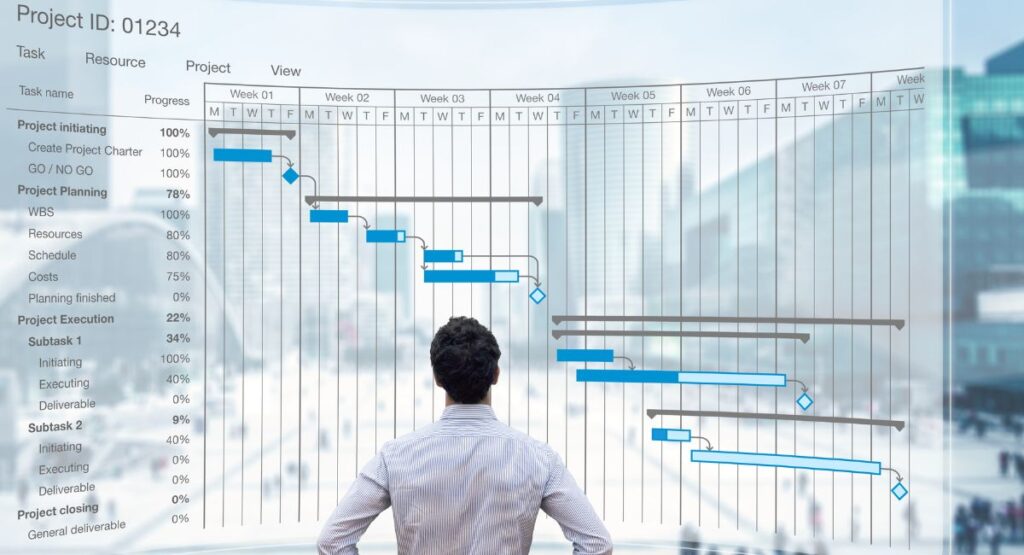We live in a globalized world where individuals and organizations can connect and interact daily through technology and other methods. Even with these essential connections, language barriers remain, causing issues with communication. There’s no question that language barriers can cause problems; however, translation agencies solve these issues by translating documents, videos, and other media.
In the 21st century, there’s a high demand for translation services to facilitate worldwide communication. As a result, translation agencies have numerous projects going on simultaneously. But how can they ensure the quality and accuracy of these projects and still meet deadlines? That’s where the translation project manager comes into play.
Table of Contents
What is a Translation Project Manager?

The translation project manager is a person who manages a translation team as they work on a translation project. They handle all projects, from the simplest to the most complex.
A translation project manager doesn’t work much on the actual translation part of the project. Their specialization is developing and using processes, software development/usage, and more. They also deal with any issues that may arise during a project, manage quality control, and ensure deadlines are met.
The main roles and responsibilities of a translation project manager can include the following:
Client Representative
Communication between a client and a translation agency is usually the responsibility of the translation project manager. This individual is the primary point of contact between the client and the translation team.
Solving Problems
Translation project managers also deal with any issues that may arise with a client and/or the translation team. These individuals are often available around the clock to deal with issues and solve problems.
For instance, the project manager deals with last-minute changes or requests made by the client. They ensure the project is set up to meet the client’s needs (technical, writing style, and more).
Maintains Confidentiality
Each translation project requires a certain level of confidentiality; for example, marketing materials for a multinational organization can’t be leaked to competitors. That’s only one example, but most projects must be done with the utmost privacy.
In addition, the translation project manager must maintain anonymity between themselves and the project editor. These individuals mustn’t influence one another during a translation project.
Moreover, the project manager must ensure strict anonymity between themselves and the translators. This allows the editors to be more direct when critiquing the team’s work. In this way, the team can work more effectively and efficiently.
Creates the Translation Team
Another responsibility of the translation project manager is to create the translation team. Putting together a translation team means finding individuals who can work together and who have suitable credentials to work on specific projects.
The project manager must also find team members who are subject matter experts for each project.
Ensures Deadlines Are Met & Plans Schedules
Another responsibility of the translation project manager is to create project schedules and ensure that all deadlines are met.
The project manager constantly monitors the team’s progress. If they find any issues affecting the deadline, they ensure it will be met on time.
During periods of high demand, it may be necessary for the project manager to adjust the team’s capacity. Sometimes, they may need to hire additional translators to help the team stay on schedule.
Oversees Tools, Documentation, and More
The translation project manager also ensures they have the right tools and software for each project. They also manage the documentation and translation process.
Each translation project has a workflow, specific resources, and documentation to ensure a smooth process and that its deadlines are met. Translation project managers also create quality assurance checklists, which are used to ensure quality and to determine potential issues and how to deal with them.
Once a project has been completed, the project manager analyzes the project history. They use the data from this review to make improvements to future projects.
The translation project manager must also assess each team member’s work and output. The data is used to determine how productive the team was (or not).
Successful Completion
Upon completion of the translation project, the translation project manager performs a quality assurance check and then sends the finished project to the client. They ask for the client’s feedback and work with them to address any issues found.
How to Plan and Manage a Successful Translation Project: The Six Best Practices

Now that you understand how a suitable translation project manager works, how can you ensure that your translation project will succeed? We’ve put together six best practices to make sure each of your translation projects is effective and efficient.
1. Detailed Scope and Requirements Gathering
The first step is to create a detailed project scope and an in-depth list of requirements. With this information, you’ll have everything necessary to develop an effective strategy for your translation projects.
As you develop the project’s scope, it’s essential to do the following:
- Ensure your team understands the source language, target language, content type, word count, and how complex the project is (or isn’t)
- Identify key deliverables (the number of files, formats, and more)
- Determine the essential KPIs that will be used to evaluate the team’s performance (more on this in a later section)
- Set the project budget and timeline
2. Choosing the Right Team
With the project essentials determined, it’s time to choose the right team. Your translation team will need to include the following individuals:
- Translation project manager
- Translators (who are native speakers of either the source or target languages)
- Editors
- Proofreaders
- SMEs (Subject Matter Experts)
3. Clear Communication
Once you’ve assembled the team for your translation project, it’s essential to clearly communicate what is expected of the team, including the following:
- Establishing clear roles and responsibilities for the team members
- Determining expectations for communication methods and frequency
- Scheduling regular check-ins to determine progress and address any issues that develop
- Setting out KPIs that will be used to measure each team member’s productivity
4. Quality Control
To ensure your translation project is a success, it’s also necessary to establish quality control protocols. It can take several rounds of reviewing, editing and proofreading to ensure the project is done correctly. But being correct isn’t the only matter you’ll deal with in quality control. It’s also making sure the content/media meets the language and cultural preferences of the target audience.
Be sure to implement rigorous quality checks at various stages of the project. These quality checks guarantee accuracy and consistency. All quality checks need to be done before delivering the project to the client. Professional translation companies like Pollion always do a quality check before project delivery. Doing so ensures a successful project and a happy client.
Quality control means checking the translated content for the following:
- Grammar and spelling
- Proper cultural localization
- Subject matter is correct
- Terminology is consistent
Along with your team members, you should also use software during quality assurance. The software, together with the team, can facilitate finding errors and ensuring the project is completed to the highest quality possible.
5. Utilize Technology
Using technology is crucial to the success of your translation project. Translation technology can help your project in these ways:
- Increase consistency across the content
- Improve team efficiency by automating some of the tasks
- Speed up the delivery time for each project (making the team more productive and efficient)
A couple of examples of translation technology tools include CAT tools, translation management systems, and machine learning software.
6. Feedback & Iteration
Once the translation project has been checked for quality assurance, it will be delivered to the client. The translation project manager usually handles this.
The client reviews the work and offers feedback. Their feedback may include suggestions for the next project, errors found, and more.
It’s essential to use client feedback and make the necessary changes they’ve requested. This not only improves the quality of the project but it makes the client happier with the work. Clients pleased with the translation work are more likely to return with future projects for the team.
Again, the translation project manager is the point of contact for the client. It’s the project manager’s job to relay the feedback to their translation team and ensure all changes are corrected as requested by the client.
Finally, the translation project manager can use client feedback to improve the translation process for future projects.
How to Measure Projects?

Translation projects can be challenging for the translation project manager to oversee. They must oversee their translation team and each step in the translation process.
A translation project manager must oversee the following:
- Tasks: Tasks in a translation project might range from document preparation, translation, proofreading, and quality assurance to final delivery. Monitoring and measuring each task helps in the timely completion and maintaining the project’s quality.
- Jobs: jobs refer to specific roles or assignments within the project, such as translator, proofreader, or editor. Keeping a clear record of each job ensures that every aspect of the project is accounted for and efficiently managed.
As mentioned earlier, it’s necessary to determine specific KPIs to measure a translation project’s success. But which KPIs should be measured?
What KPIs Should You Measure?
The translation project manager is responsible for measuring the right KPIs for each translation project. But which ones should they measure?
- Turnaround time: how long it takes to complete the project from start to finish.
- Quality metrics: number of revisions or corrections made after the first draft.
- Translator productivity: the number of words translated per hour or day by each translator.
- Client satisfaction: feedback scores or reviews from clients post-delivery.
- Cost efficiency: cost per word or page, ensuring the project stays within budget.
- Consistency: using tools to measure the consistency of terminology and phrasing across the translated content.
When measuring the right KPIs, the translation project manager can ensure that each project is cost-effective and is finished on time.
Conclusion
The translation project manager is an essential part of any translation project. With effective translation project management, they ensure high-quality translation outputs. They also work closely with the client, addressing any issues or changes the client may request during the project or after its completion.
A successful translation project manager continuously learns, works with feedback exchange, and is adaptable as the translation industry evolves.
When searching for a translation agency, it is essential to choose a professional translation agency, such as Pollion, which maintains long-term relationships with its translation project managers. This is a crucial feature of a translation agency that ensures your project is done to the highest quality possible.
Read More:
